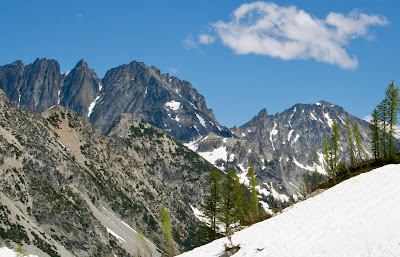About 45 years ago, I arrived at the Blue Mountain Work Center near Austin Junction, east of Prairie City, Oregon, from Eugene. A young college student at the University of Oregon School of Journalism in 1974, I was hired that summer as a wandering factotum -- sort of a jack-of-all-trades -- by the Malheur National Forest.
The year before, I worked as a tour guide at Crater Lake Lodge, Inc. This time around, it would be no glamour detail. I’d have to work, backpack and engage wilderness users throughout the entire forest. On the Malheur National Forest, I worked on all four ranger districts on the forest (Long Creek, Prairie City, Hines and Bear Valley).
I explored virtually the whole forest during my 6-month stint there. On Long Creek, I served as weekend sub on the Indian Rock Lookout (elevation 7,375), and Dixie Lookout (elevation 7,511). On the Prairie City District, I pulled sub duties on Antelope Lookout (elevation 6,456). Also marked timber and subbed on the helitack crew.
This wilderness is fairly small (68,700 square acres). By comparison, the Glacier Peak Wilderness, where I worked for nearly the next decade, is 566,057 square acres. We had no fewer than 15 wilderness rangers in Glacier Peak on six districts. I was one of that dedicated group of "wilderness strangers" for eight summers.
Yes, you’d be surprised how many obscure but tall peaks there are in the great divide between the Snake and Columbia Rivers near John Day. However, they are nothing a pissant couldn’t hop over compared to the North Cascades (below), where I would soon land, staying from 1975-82, and meet my lovely bride of 41 years.
As an aside, read “Astoria: Astor and Jefferson’s Lost Pacific Empire” by Peter Stark, where you’ll learn that John Day was a member of Astor’s overland party. He died nearby in a skirmish with the natives. No wonder Malheur is called “bad times” or “misfortune” by the French voyageurs who were part of the overland party.
After living at the Blue Mountain Work Center in Austin Junction, I moved the Forest Service housing in Prairie City (above), Yes, it’s the hub of cattle country (Oxbow was the big one), but timber production had gone downhill in the 70s, when the Hines mills shut down in John Day, Bates and other locations.
Prairie City is a one-horse town. John Day has slightly more to offer in terms of consumer goods. After all, it is the biggest town in Grant County. Still not much to look at, though. It’s a major intersection for two U.S. highways. I like Canyon City, in the shadow of Canyon Mountain two miles south of John Day. Much better pizza, too.
The Sumpter Valley Road (now Oregon Route 7) from Austin Junction to Baker City is very scenic and features many ghost towns (Austin, Whitney, Greenhorn and Granite, to name a few). I love ghost town lore, The Sumpter Valley Road to Baker City was paved a couple years after I left Austin Junction.
Much like other Eastern Oregon towns, they roll up the sidewalks about 9 p.m. Better be well stocked at home. As a college student from Eugene, I kept a pretty low profile among the NRA/bubba types in the John Day Valley. They would have executed me by firing squad if they could. It’s still Trump country, but imagine 1974.
In 1975, I was enticed to apply for a position on the Wenatchee National Forest by a girl I had met in Prairie City. Our romance didn’t work out, but I began a life-long love affair with the North Cascades, which are much more spectacular than anyplace in Eastern Oregon. Nonetheless, I very much enjoyed my stint on the Malheur.
On the Lake Wenatchee District alone, we had a dozen over 8,000- and 9.000-footers, including Clark Mountain (pictured) Mt. Maude, Seven-Fingered Jack, Buck Mountain, Copper Peak, Chiwawa Mountain, Fortress Mountain, Copper Mountain and others. And these peaks begin at 1,800 feet above sea level.
And did I even mention the glaciers? Glacier Peak has glaciers in its butt crack and creases. Washington has 90 percent of the glaciers in the Lower 48. Eastern Oregon might have one in the Eagle Cap Wilderness Area. I would know. Trails are steeper, and lusher with vegetation. And bugs.
Nonetheless, Oregon and Washington are both beautiful for many reasons. I’m grateful to have explored the wilderness in both states: Kalmiopsis Wilderness Area (Brookings), Crater Lake and environs, Three Sisters, Mt. Jefferson and especially Mt. Hood (below) and Mt. St. Helens, along with Glacier Peak and environs.
Wednesday, September 18, 2019
Saturday, September 14, 2019
Litany Of Paradox
Bizarro World is a fictional planet from my years reading Superman comics in the early 1960s. Introduced as a cube-shaped world, home to Bizarro Superman, who is bad, and Bizarro Joker, who is good, and other anomalies, the planet is weirdly inverted.
Welcome to the United States of 2019, where the bizarre has become commonplace, thanks to Herr Gropenfuhrer, Moscow Mitch and their odd band of pirates and dingbats. Today, up is down, science is bunk, good is bad, and democracy is an authoritarian oligarchy.
These are desperate times, people. Desperate times call for desperate measures. As such, I conducted a conference call with all three correspondents for the GonzoPR blog: Helmut Vallindaklopf, Wolfgang Majoris and Ramona Vallindaklopf.
JM: “Greetings, staff. Thank you for joining me at this odd time of the day. I know it’s late in Genoa, working hours in Eugene, and not yet dawn in Bangkok. So, I really appreciate your participation.”
RV: “Well, sure, JM. It’s well past cocktail your here, so I apologize in advance if I sound a tad vulgar.”
HV: “Wish it was cocktail hour here in D.C., sis. I suppose it’s close to 5 p.m., so that will be my excuse.”
WM: “Hey, I haven’t even had my tea here in the empire of the sun. I must get a pot going.”
JM: “I think we can all assume that it’s going to get weirder for Herr Gropenfuhrer before Election 2020, right? What can you report from your underground lair on Connecticut Avenue, Helmut?”
HV: “Uh, you forgot a few things for your litany of paradox, JM. For one thing, truth has become lies. The pattern is clear, and the tactics have become painfully obvious. The First Amendment is under attack. Truth is not negotiable.”
JM: “And what of ‘Sharpiegate,' Helmut?”
HV: “Indeed, another example of distorted truth from Bizarro World. Herr Gropenfuhrer fancies himself a meteorologist. Hey, I’ve got an idea! Let’s drop a nuclear bomb on that hurricane. We’ll show that storm who is boss.”
RV: “And don’t forget about another key message from Bizarro World. Friends are enemies and enemies are friends. What’s-his-name wants to be buddies with the Taliban all of a sudden, while Denmark, Germany and other European allies are persona non grata?”
WM: “Yes, Ramona, and don’t forget his pal Kim Jong-Un is exalted by Herr Gropenfuhrer, while Japan and South Korea say: ‘what?’”
JM: “Truly bizarre. We can’t stop fighting now. This is bat country. We must resist and retaliate.”
WM: “Indeed. Freedom is something that dies unless it’s used. We must rally the troops and oust that imbecile from office.”
JM “Yes, we must vote, and pray to God but row away from the rocks. Too early for cocktails in Bangkok, Wolf?”
WM: “As Helmut so eloquently stated, it’s 5 p.m. somewhere.”
Monday, September 2, 2019
The Pointless Man
In “The Point,” a 1971 animated story by Harry Nilsson and Carol Beers, the protagonist, a little boy named Oblio, is banished from his home to the Pointless Forest because he “has no point.” He is unfairly tried and convicted, along with his dog, Arrow, for this alleged crime by the evil Count, who loathes Oblio's apparent pointlessness.
In the Pointless Forest, he encounters the Pointless Man, who proves to be the most pointless of beings. His opinions and positions are thoughtless and rushed; he is a false prophet. He is harsh, petty, fickle and unreliable. But he notes, “a point in every direction is like no point at all. Any fool can do that.”
In the Pointless Forest, he encounters the Pointless Man, who proves to be the most pointless of beings. His opinions and positions are thoughtless and rushed; he is a false prophet. He is harsh, petty, fickle and unreliable. But he notes, “a point in every direction is like no point at all. Any fool can do that.”
Later, Oblio meets the Rock Man, who says that “there ain’t nothing pointless about this gig. Hey, man, you don’t have a point (on your head), to have a point.” In other words, what is pointlessness, and who gets to make that decision? Everyone and everything Oblio meets refuses to fit into a binary box, an easy label.
Couldn’t help but connect the dots between Herr Gropenfuhrer and The Pointless Man. I thought it was high time for some wisdom from Helmut Vallidaklopf, correspondent for the Americas for the GonzoPR blog who’s undercover in his basement bunker along Connecticut Avenue near the White House.
JM: “Yes, indeed. And, the law has been usurped by Herr Gropenfuhrer and his minions and appeasers.”
HV: “The analogy between the Pointless Man and Herr Gropenfuhrer is uncanny. He points a finger in all directions to blame Americans for its woes: the Democrats, Hillary Clinton, immigrants, American people of color, sunspots. Plus he has a case of Obama envy.”
Couldn’t help but connect the dots between Herr Gropenfuhrer and The Pointless Man. I thought it was high time for some wisdom from Helmut Vallidaklopf, correspondent for the Americas for the GonzoPR blog who’s undercover in his basement bunker along Connecticut Avenue near the White House.
JM: “Good morning, Helmut. How goes the battle? Keeping cool?”
HV: “Keeping the faith and staying cool as a rock.”
JM: “So you’ve seen ‘The Point,’ eh? Do you also see the comparisons between the Pointless Man and Herr Gropenfuhrer?”
HV: “Oh, yes. As you may remember, when Oblio returns to the Pointless Village, the denizens of the land are overjoyed to see him. None of them felt good about the rules that sent him away in the first place, and his return has galvanized them to stand up to the rules of the law itself. We must regain control.”
HV: “The analogy between the Pointless Man and Herr Gropenfuhrer is uncanny. He points a finger in all directions to blame Americans for its woes: the Democrats, Hillary Clinton, immigrants, American people of color, sunspots. Plus he has a case of Obama envy.”
JM: “Indeed. He must go. We must reject the authoritarian rule of the land with the power of our votes. Well, keep cool, amico mio. I suggest a tall Paulaner or Spaten at cocktail hour.”
Subscribe to:
Posts (Atom)



















